Did you know that over 80% of dogs suffer from some form of dental disease by age three? This statistic highlights the importance of dental health for our furry friends.
Dogs need proper oral care to prevent diseases and maintain overall health like humans. One essential tool in keeping your dog’s dental hygiene is a toothbrush.
A dog toothbrush comes in various types and sizes, designed to cater to different breeds and sizes of dogs. Choosing the right toothbrush can make a significant difference in keeping your dog’s teeth clean and healthy.
In this article, we will explore the importance of dental health for dogs, discuss different types of dog toothbrushes available in the market, provide tips on choosing the right one for your furry friend, and offer some helpful advice on how to brush your dog’s teeth effectively.
Key Takeaways
- Dogs require proper oral care to prevent diseases and maintain overall health.
- Choosing the right toothbrush is essential for effective cleaning, and it should fit comfortably in your hand and your dog’s mouth.
- Bristle softness, brush head size, and durable materials are crucial factors to consider when selecting a toothbrush.
- Regular brushing, dental chews, mouth washing, and professional cleaning can significantly improve a dog’s dental health and prevent costly dental procedures.
The Importance of Dental Health for Dogs
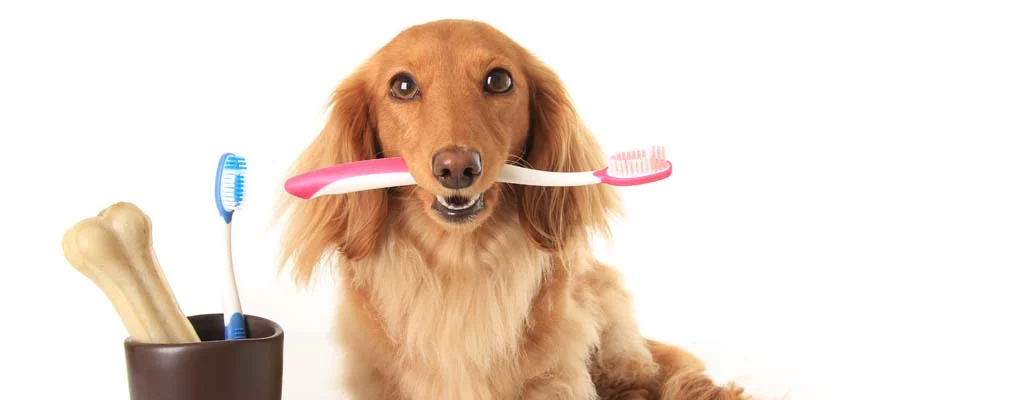
You know that cleaning your furry friend’s teeth with a dog toothbrush is crucial for their overall health and well-being, right? Like humans, dogs need healthy teeth and gums to prevent health risks.
Preventative measures, such as brushing their teeth regularly with a dog toothbrush, can help reduce the risk of dental issues. Poor dental hygiene in dogs can lead to various health problems, including bad breath, gum disease, and even heart disease.
Bacteria from infected gums or teeth can enter the bloodstream and travel to other organs like the heart, causing severe complications. Taking care of their dental hygiene with a dog toothbrush from an early age ensures that your furry companion stays healthy and happy for years to come.
Types of Dog Toothbrushes
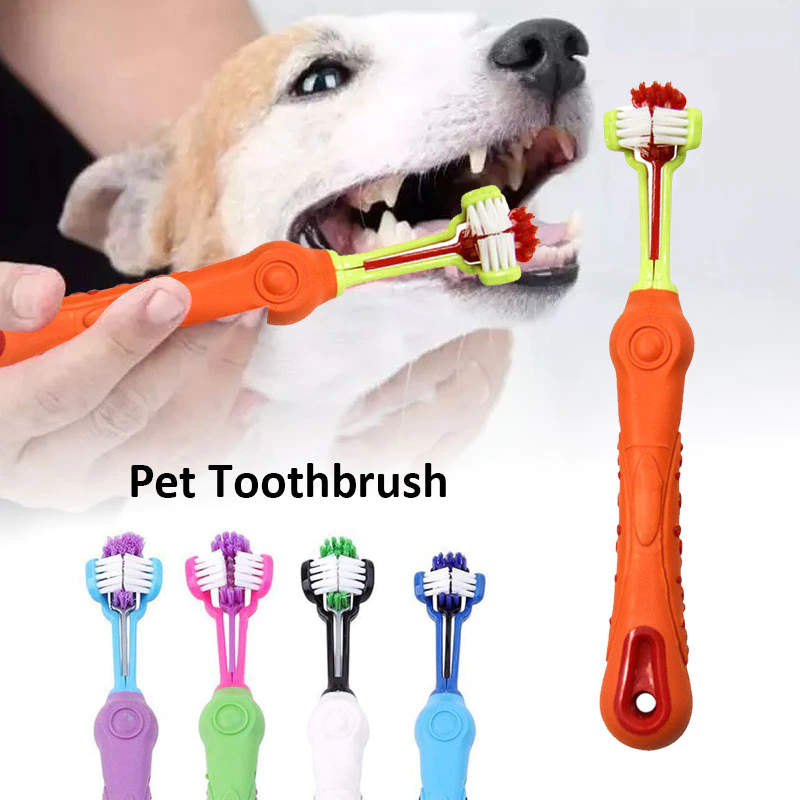
If you’re looking for a more convenient way to clean your furry friend’s teeth, a variety of brush types can make the process easier and more effective.
One primary consideration when choosing a toothbrush for your dog is using an electric or manual option. Electric toothbrushes can be more efficient at removing plaque and tartar buildup, but they may also require training before your pup feels comfortable with the buzzing sensation.
Another essential factor to consider is the bristle material. Natural bristles made from animal hair or synthetic bristles made from nylon can effectively clean teeth. However, natural bristles may be gentler on gums, while synthetic options can be more durable over time.
Ultimately, choosing a brush that fits comfortably in your hand and allows you to reach all areas of your dog’s mouth easily is essential. Regular brushing using the right toothbrush can help keep your pup’s pearly whites healthy and strong for years to come!
How to Choose the Right Dog Toothbrush
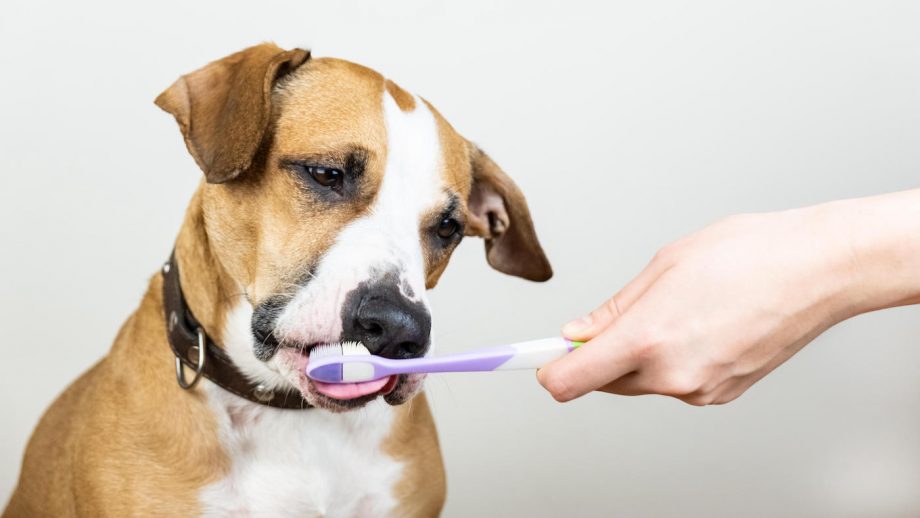
Pet owners must consider several factors when choosing the right toothbrush for their furry friend.
The size and shape of the toothbrush should be appropriate for the dog’s mouth and teeth.
Bristle softness ensures they don’t hurt or irritate the dog’s gums while brushing.
Lastly, durability should be considered to ensure that the toothbrush lasts long enough to make it a worthwhile investment.
Size and Shape
The size and shape of a dog toothbrush significantly impact its effectiveness in cleaning your furry friend’s teeth. When choosing the right toothbrush for your pup, it’s essential to consider these factors carefully.
Here are some things to keep in mind:
- Best materials: A high-quality toothbrush made from durable materials is essential for effective cleaning. Look for brushes made from soft nylon bristles that won’t damage your dog’s gums or teeth. Additionally, choose a meeting with a sturdy handle that won’t break easily and fits comfortably in your hand.
- Ergonomic design: The shape of the brush can also make a big difference in how well it works. An ergonomic design will help you reach all areas of your dog’s mouth more quickly, making brushing less stressful for you and your pet. Consider the size and shape of your dog’s mouth when selecting a brush to ensure it can reach all areas.
By considering the best materials and ergonomic design when choosing a toothbrush for your furry friend, you can ensure effective cleaning while keeping their comfort in mind.
Proper brushing techniques and consistent use of an appropriate tool can help prevent dental problems and keep your teeth healthy and strong.
Bristle Softness
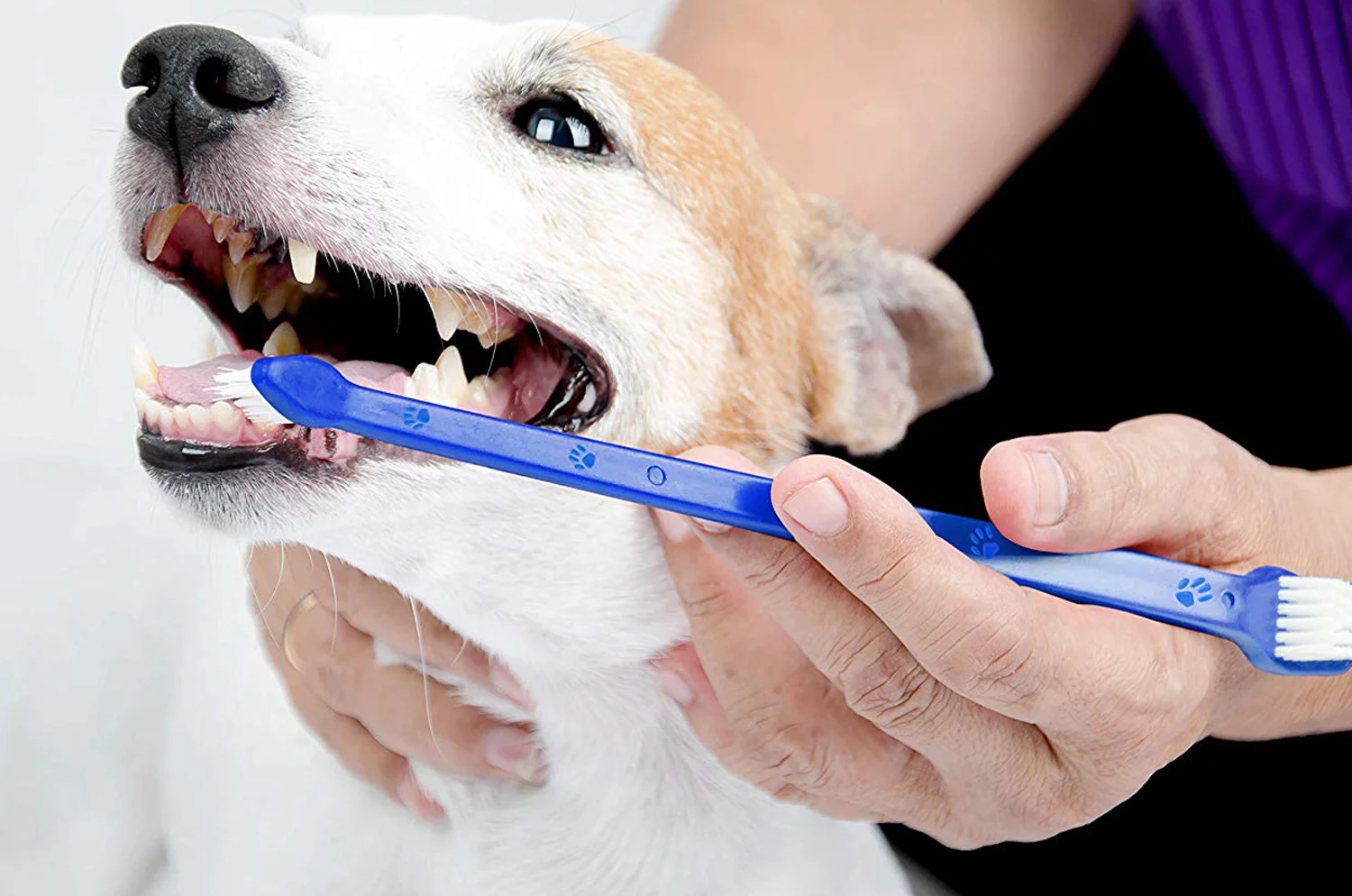
To ensure a comfortable brushing experience for your furry friend, it’s essential to choose a toothbrush with soft bristles. When selecting the right dog toothbrush, bristle stiffness is a crucial factor. Soft bristles are gentle on your pet’s gums and teeth, preventing injury or discomfort during their oral care routine.
In addition to bristling softness, the brush head design ensures effective cleaning. A well-designed brush head should be small enough to fit comfortably inside your pet’s mouth while reaching all the nooks and crannies where plaque and tartar can build up.
With the right combination of soft bristles and a well-designed brush head, you can keep your pup’s dental health in tip-top shape without causing any unnecessary discomfort or pain.
Durability
You’ll want a durable option for your furry friend’s oral care routine, ensuring that the toothbrush can withstand regular use and last for an extended period. When selecting a dog toothbrush, it’s essential to consider the product’s longevity.
Here are some factors to keep in mind when evaluating durability:
- Material quality: The toothbrush should be made from high-quality materials that won’t break or crack easily. Look for options with sturdy handles and bristles that won’t shed after just a few uses.
- Size: Choose a brush appropriate for your dog’s size and breed. A larger dog will need more extensive meetings with more robust bristles, while smaller dogs will require gentler bristles.
- Cleaning frequency: If you plan on brushing your dog’s teeth daily, you’ll want to invest in a toothbrush that can handle frequent use without breaking down quickly.
- Brand reputation: Consider purchasing from reputable brands that produce quality dental products for pets.
By considering these factors, you can select a durable dog toothbrush that will provide effective cleaning over an extended period. This ensures better oral health for your pet and saves money in the long run by avoiding frequent replacements due to wear and tear.
Tips for Brushing Your Dog’s Teeth
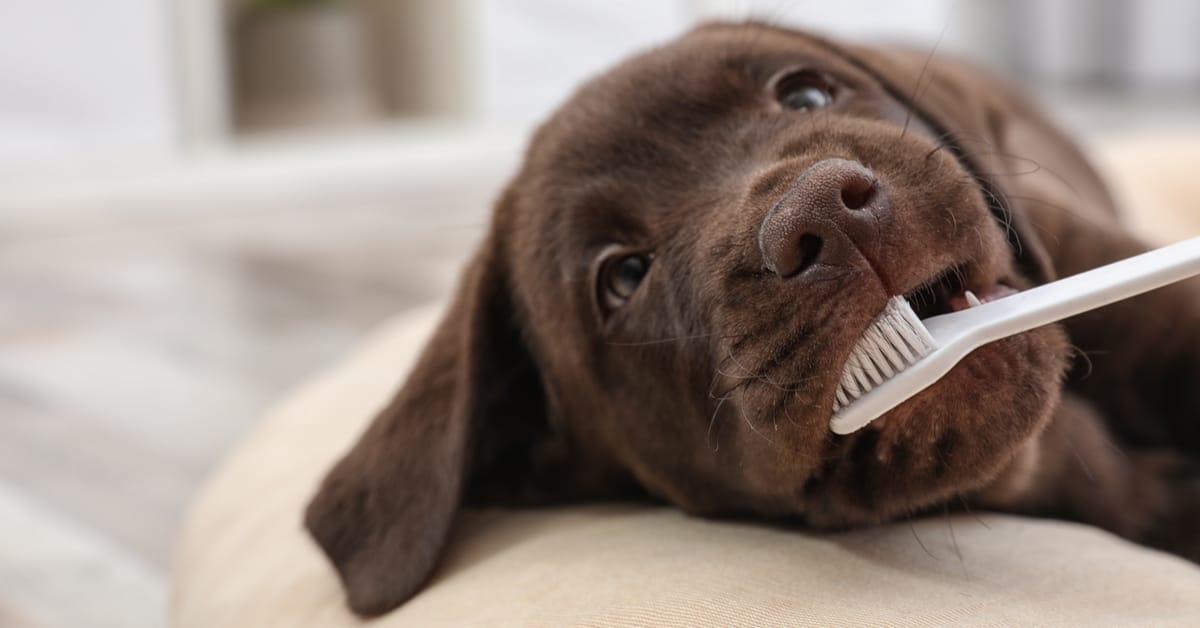
When maintaining a dog’s oral health, brushing their teeth is essential. There are a few key points to consider to ensure that this task is done correctly.
First and foremost, positively introducing a toothbrush can make all the difference in how receptive your dog is to brushing their teeth.
Secondly, proper technique can mean the difference between effective cleaning and going through the motions.
Finally, establishing a regular frequency of brushing will help keep your dog’s teeth healthy for years to come.
Introducing the Toothbrush
Imagine holding the dog toothbrush in your hand, with its soft bristles and easy-to-grip handle. This specially designed toothbrush for dogs is essential for pet owners who want to maintain their furry friends’ dental health.
The toothbrush design makes reaching all of your dog’s teeth and gums easy, ensuring that no plaque or tartar buildup goes unnoticed. Here are five reasons why introducing a dog toothbrush into your pet’s oral hygiene routine is crucial:
- Regular brushing helps prevent bad breath, making snuggling with your furry friend a much more enjoyable experience.
- It reduces the risk of gum disease and other dental problems that can cause pain and discomfort for your pet.
- By preventing dental issues, you’ll save money on costly vet bills.
- Brushing your dog’s teeth strengthens the bond between you and your pet by showing them how much you care about their well-being.
- A healthy mouth means a healthier overall body, as bacteria from poor oral hygiene can spread to other body parts.
Using the Right Technique
Don’t let your furry friend suffer from painful dental problems; use the proper brushing technique today and show them how much you care about their health.
Proper technique is crucial in maintaining good oral hygiene for your beloved pet. To ensure that you’re doing it correctly, there are two things to remember: Proper grip and brushing direction.
First, make sure to have a proper grip on the toothbrush. Hold it at an angle of 45 degrees towards the gum line and use gentle circular motions to clean both sides of each tooth. Avoid using too much pressure as this can cause damage to their gums and teeth.
Secondly, brush in the direction of their teeth’s natural growth pattern. This will help remove any plaque or tartar buildup while preventing discomfort for your furry friend.
By following these simple steps, you can easily maintain healthy teeth and gums for your dog, ultimately improving their overall well-being.
Frequency of Brushing
Brushing your pet’s teeth regularly can significantly improve their oral health, and according to the American Veterinary Dental Society, only 2% of dogs receive adequate dental care at home. One of the most important factors to consider when brushing your dog’s teeth is the frequency. Many dog owners think that brushing once a week is enough, but this is not true. The effectiveness of brushing largely depends on how often it is done.
Frequency vs. Effectiveness
To understand how often you should brush your dog’s teeth, it is essential to know how it works; just like humans, plaque and tartar buildup in a dog’s mouth over time. Brushing helps remove these harmful substances from their teeth and gums before they cause serious dental problems such as gum disease or tooth decay. While there are no hard and fast rules for how often to brush your dog’s teeth, experts recommend doing so at least thrice weekly for maximum effectiveness.
Common Mistakes
One common mistake many pet owners make is waiting until their dog has noticeable dental problems before starting a regular brushing routine. Another mistake is using human toothpaste instead of specifically formulated canine, which can be toxic for pets. By brushing regularly with a proper technique and using canine-friendly products, you can help prevent serious dental issues that could lead to costly vet bills. Overall, prioritizing your pet’s oral health by establishing a consistent brushing routine can ensure their overall well-being.
Frequency Emotion
Rarely Neglect
Sometimes Indifference
Often Responsibility
Consistently Love & Care
Daily Devotion & Commitment
Other Dental Care Products for Dogs
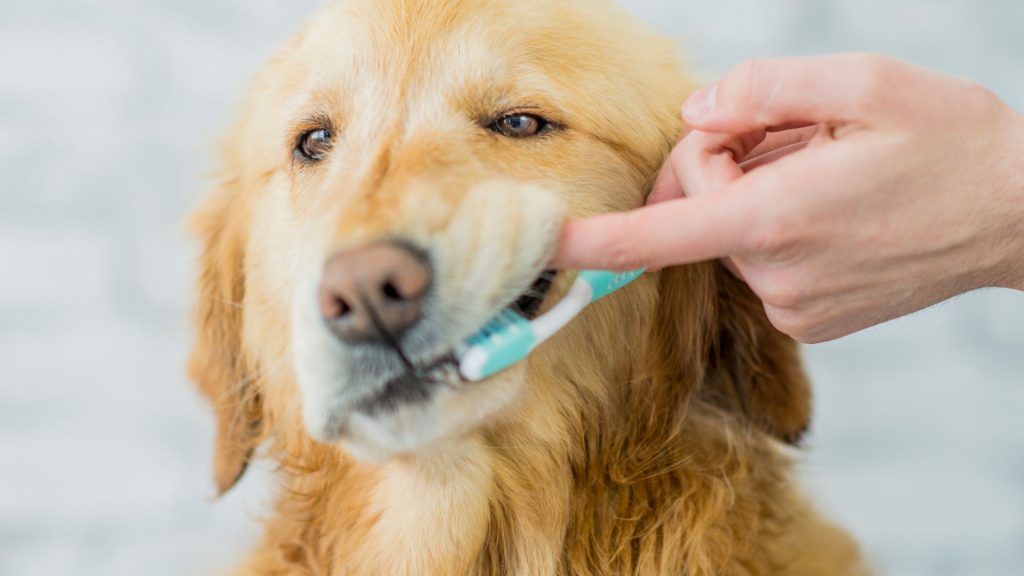
Dog owners serious about maintaining their pet’s dental health should consider using other dental care products besides a toothbrush.
Three such products are dental chews, mouthwash, and professional cleanings.
Dental chews help remove plaque and tartar buildup while also freshening breath.
Mouthwash can kill bacteria and reduce bad breath.
Professional cleaning by a veterinarian can provide a deep cleaning that cannot be achieved at home.
Dental Chews
You’ll love how easy it is to give your furry friend a healthy smile with these dental chews. Not only are they a tasty treat for your pup, but they also help clean their teeth and freshen their breath. Dental treatments are designed to remove plaque and tartar buildup as your dog chews, promote good oral health and prevent dental diseases.
If you’re looking for DIY alternatives, plenty of options are also available. Some pet owners prefer making dental chews using ingredients like sweet potato slices or frozen carrots. Just be sure to avoid any ingredients that harm your dog’s teeth or digestive system. No matter which option you choose, incorporating dental chews into your pup’s routine can make a big difference in their overall health and happiness.
Mouthwash
Using mouthwash is an effective way to freshen your pup’s breath. Studies show that up to 80% of dogs over three have some form of dental disease. Mouthwash can help reduce bacteria and plaque buildup in your dog’s mouth, improving oral health. The benefits of using mouthwash go beyond just fresher breath; it can also prevent gum disease and tooth decay.
When choosing the right mouthwash for your dog, it’s essential to consider their specific needs. Some mouthwashes are designed for dogs with sensitive teeth or gums, while others focus on reducing tartar buildup. You need to read the labels carefully and consult a veterinarian if you need clarification on which product is best for your furry friend.
Incorporating a routine of regular brushing, dental chews, and mouthwash into your dog’s daily care can significantly improve their dental health. This will keep them smiling brightly for years to come.
Professional Cleanings
For optimal dental health, it’s recommended that a professional cleaning be scheduled at least once a year for your furry companion. Regular cleaning has several benefits, including preventing tooth decay, bad breath, and gum disease. It’s important to note that while regular brushing at home is essential for maintaining good oral hygiene, it cannot replace the deep cleaning provided by professional cleanings.
Many pet owners may need help with the cost of professional cleaning versus at-home care. However, in the long run, regular professional cleanings can save money by preventing costly dental procedures. Many veterinary clinics offer package deals or discounts on preventative care services like dental cleaning. Investing in your pet’s oral health now can lead to a healthier and happier life for them in the future.
Benefits of Regular Professional Cleaning Cost Effectiveness of Professional Cleaning vs. At-Home Care
Prevents tooth decay Saves money in the Long Run
Reduces lousy breath Many clinics offer package deals or discounts
Prevents gum disease Helps maintain overall health
Providing deep cleaning is not possible with at-home care
By prioritizing regular professional cleaning for your furry friend’s dental health, you’re ensuring their comfort and well-being and potentially saving yourself money in the long run. Ask your veterinarian about preventative care options and take advantage of discounts or packages. Your pet will thank you with a happy smile!
Frequently Asked Questions
Are electric toothbrushes better for dogs than manual toothbrushes?
When it comes to dental care for dogs, both electric and manual toothbrushes have their pros and cons. Natural options like dental chews and bones can also be effective. Consider your dog’s individual needs and preferences when choosing a toothbrushing method.
How often should I brush my dog’s teeth?
Keeping up with the frequency of dog teeth cleaning is crucial for their oral health. Owners should use the best toothbrush for dogs to brush their pup’s teeth at least 2-3 times a week to prevent dental problems and promote overall well-being.
Can I use human toothpaste on my dog’s teeth?
Human toothpaste is an excellent alternative to dog toothpaste…if you want your dog to suffer from upset stomach, vomiting, and diarrhea. Sticking with toothpaste specifically formulated for dogs is best to avoid potential risks.
What are some signs that my dog may have dental health issues?
Dogs with dental issues may experience bad breath, loose or missing teeth, bleeding gums, and difficulty eating. Regular dental check-ups are essential to prevent these issues and maintain a dog’s overall health.
Are there any natural alternatives to dog toothpaste?
Are you looking for a natural alternative to dog toothpaste? DIY toothpaste can be made with coconut oil, baking soda, and parsley. Natural remedies like raw bones or carrots can also help keep your pup’s teeth clean and healthy.
See Also:
- Waterproof Dog Bed: Discover the Ultimate Comfort for Your Furry Friend
- Discover Exciting Dog Walking Jobs for Pet Lovers
- Why Dogs Sleep With Their Bums Facing You: Embrace the Bond Discovering the Heartwarming Secrets
Conclusion
In conclusion, dental health is crucial for dogs’ well-being. Neglecting this aspect of their care can lead to serious health issues. Fortunately, there are various types of dog toothbrushes available in the market that pet owners can choose from depending on their furry friend’s needs.
While choosing a dog toothbrush, it’s essential to consider factors like size, bristle softness, and handle grip. With the right brush and proper technique, brushing your dog’s teeth can become comfortable and enjoyable for you and your pet. However, if brushing isn’t an option for some dogs or requires additional support, other dental care products like chews or water additives can supplement oral hygiene efforts.
Ensuring good dental hygiene is one way to keep our pets happy and healthy. Taking small steps towards maintaining our four-legged friends’ physical well-being can provide them with a happy life full of tail wags and sloppy kisses.
Join the Journey of Compassion: Support Bone Voyage Dog Rescue Today and Help Give Homeless Dogs a Bright Future!
